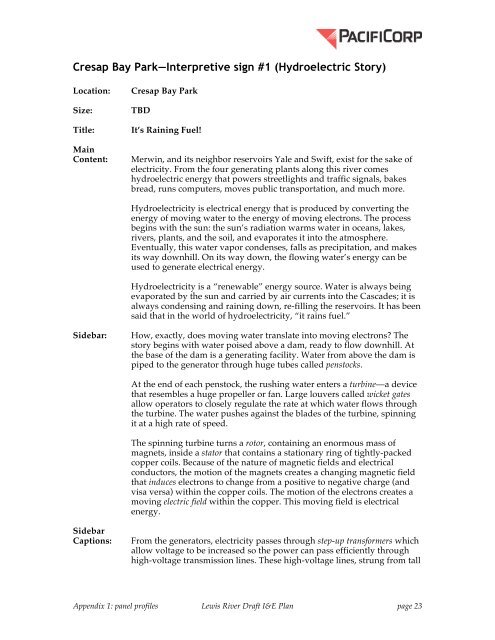The Lewis River Hydroelectric Projects - PacifiCorp
The Lewis River Hydroelectric Projects - PacifiCorp
The Lewis River Hydroelectric Projects - PacifiCorp
Create successful ePaper yourself
Turn your PDF publications into a flip-book with our unique Google optimized e-Paper software.
Cresap Bay Park—Interpretive sign #1 (<strong>Hydroelectric</strong> Story)<br />
Location:<br />
Size:<br />
Title:<br />
Main<br />
Content:<br />
Cresap Bay Park<br />
TBD<br />
It’s Raining Fuel!<br />
Merwin, and its neighbor reservoirs Yale and Swift, exist for the sake of<br />
electricity. From the four generating plants along this river comes<br />
hydroelectric energy that powers streetlights and traffic signals, bakes<br />
bread, runs computers, moves public transportation, and much more.<br />
<strong>Hydroelectric</strong>ity is electrical energy that is produced by converting the<br />
energy of moving water to the energy of moving electrons. <strong>The</strong> process<br />
begins with the sun: the sun’s radiation warms water in oceans, lakes,<br />
rivers, plants, and the soil, and evaporates it into the atmosphere.<br />
Eventually, this water vapor condenses, falls as precipitation, and makes<br />
its way downhill. On its way down, the flowing water’s energy can be<br />
used to generate electrical energy.<br />
<strong>Hydroelectric</strong>ity is a “renewable” energy source. Water is always being<br />
evaporated by the sun and carried by air currents into the Cascades; it is<br />
always condensing and raining down, re-filling the reservoirs. It has been<br />
said that in the world of hydroelectricity, “it rains fuel.”<br />
Sidebar:<br />
How, exactly, does moving water translate into moving electrons <strong>The</strong><br />
story begins with water poised above a dam, ready to flow downhill. At<br />
the base of the dam is a generating facility. Water from above the dam is<br />
piped to the generator through huge tubes called penstocks.<br />
At the end of each penstock, the rushing water enters a turbine—a device<br />
that resembles a huge propeller or fan. Large louvers called wicket gates<br />
allow operators to closely regulate the rate at which water flows through<br />
the turbine. <strong>The</strong> water pushes against the blades of the turbine, spinning<br />
it at a high rate of speed.<br />
<strong>The</strong> spinning turbine turns a rotor, containing an enormous mass of<br />
magnets, inside a stator that contains a stationary ring of tightly-packed<br />
copper coils. Because of the nature of magnetic fields and electrical<br />
conductors, the motion of the magnets creates a changing magnetic field<br />
that induces electrons to change from a positive to negative charge (and<br />
visa versa) within the copper coils. <strong>The</strong> motion of the electrons creates a<br />
moving electric field within the copper. This moving field is electrical<br />
energy.<br />
Sidebar<br />
Captions:<br />
From the generators, electricity passes through step-up transformers which<br />
allow voltage to be increased so the power can pass efficiently through<br />
high-voltage transmission lines. <strong>The</strong>se high-voltage lines, strung from tall<br />
Appendix 1: panel profiles <strong>Lewis</strong> <strong>River</strong> Draft I&E Plan page 23
















